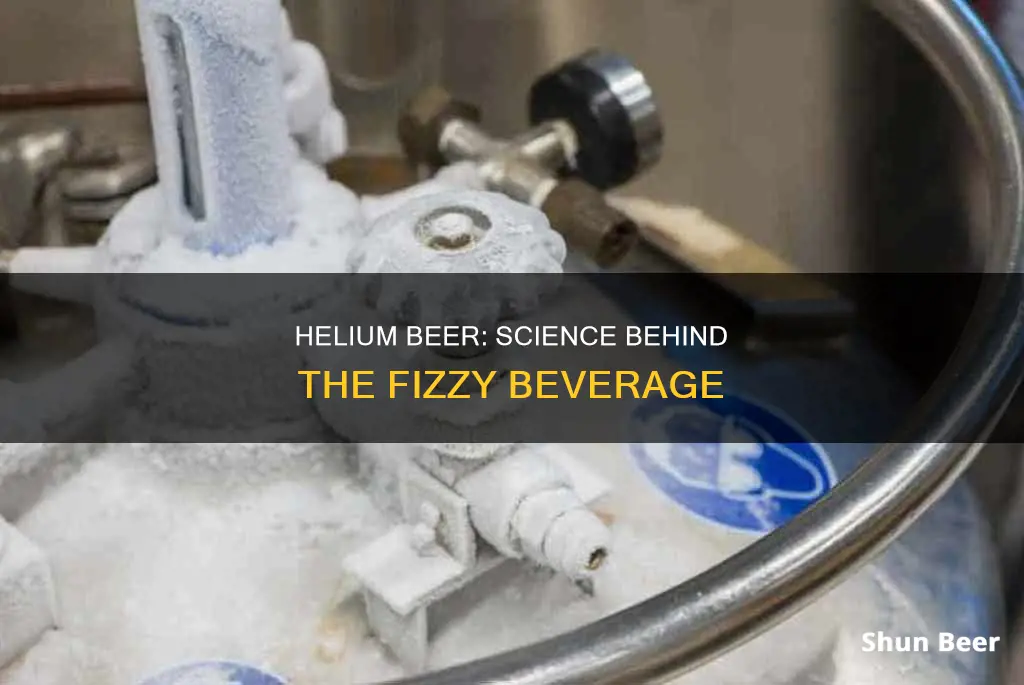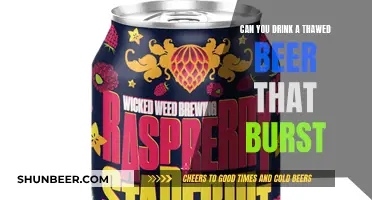
In 2014, two viral videos sparked a trend that has since become a prominent internet sensation: helium beer. The videos, one by Samuel Adams and the other by Stone Brewing Co., showed people drinking beer and their voices changing to high-pitched tones, as if they had inhaled helium. This sparked a worldwide demand for helium beer, with people asking where they could buy it and if it could be shipped overseas. However, the videos were nothing more than an April Fool's joke, and the science behind helium beer reveals that it is not possible to create such a beverage.
| Characteristics | Values |
|---|---|
| What is it? | A beer infused with helium gas |
| How does it work? | It is not possible to infuse helium into beer due to its insolubility. |
| What are the effects? | The viral videos showcasing helium beer were an April Fool's prank. |
| Is it real? | No, it is not real. |
What You'll Learn

It's impossible to infuse helium into beer
The idea of helium beer began as an April Fool's Day prank by the Boston Beer Company's Samuel Adams PR team in 2014. In their satirical video, the founder, Jim Koch, sips on "HeliYum", and his voice immediately turns high-pitched, showcasing the supposed effect of helium-infused beer. This sparked a viral trend, with Stone Brewing and other companies following suit with similar hoax advertisements. Despite the hype, infusing helium into beer is impossible for several reasons:
Firstly, helium is not soluble in water or beer. Carbonation in beer occurs when carbon dioxide or nitrogen dissolves in the liquid, creating bubbles. Helium, unlike these gases, is highly insoluble and cannot be used for carbonation. Even if helium were to be forced into the beer, it would not dissolve and would immediately escape when the container is opened, causing the beer to gush out.
Secondly, liquid helium only exists at extremely low temperatures, turning into a gas at -220°F. Adding liquid helium to beer would result in the beer freezing instantly.
Finally, even if helium could be added to beer, it would not have the same effect on the drinker's voice as inhaling helium from a balloon. Helium is one of the least dense gases, and sound travels faster through less dense gases, resulting in a higher pitch. However, to experience this effect, one would have to inhale the gas directly, rather than drink it infused in a liquid.
Thus, while the idea of helium beer sparked curiosity and excitement, it remains firmly in the realm of fantasy, with no scientific basis for its existence.
The Magic Behind Beer Engines: How Do They Work?
You may want to see also

It's an April Fool's joke
However, it is essential to understand that helium beer is not real; it is a myth. The videos were April Fool's jokes that capitalized on the entertaining idea of beer that makes your voice high-pitched. The scientific reality is that infusing helium into beer is highly improbable due to the insolubility of helium in water. Additionally, liquid helium has an extremely low freezing point, and adding it to beer would result in frozen beer.
The popularity of these prank videos and the public's fascination with the concept of helium beer led to a wave of copycat videos and articles. This phenomenon even prompted scientists to explore the possibility of creating helium-infused beer. While they discovered that the solubility levels of helium and nitrogen are similar, indicating a potential pathway for creating helium beer, the effort required to produce such a beer would be excessive, and the final product would lack the carbonation and bubbles typically associated with beer.
In conclusion, helium beer exists only as an April Fool's joke and a subject of scientific curiosity. While it captured the public's imagination, the realities of chemistry and physics make it impractical and unlikely to become a reality anytime soon.
Wet Paper Towel on Beer: Does This Method Work?
You may want to see also

It's a viral video trend
On April 1, 2014, two reputable breweries, Boston Beer Co. and Stone Brewing, simultaneously announced a revolutionary new project: helium beer. Sam Adams' founder, Jim Koch, posted a video about HeliYUM beer, claiming that his company had perfected the Noble Hops flavor and discovered a way to take advantage of helium's properties to produce a truly remarkable brew. Similarly, Stone Brewing informed beer lovers about their Stochasticity Project Cr(He)am Ale with helium. These videos, which were elaborate April Fool's Day jokes, quickly went viral, sparking a trend of copycat videos and sparking interest from beer enthusiasts worldwide.
The helium beer trend took off, with people eager to get their hands on this unique brew. The original videos sparked a wave of copycat videos, with people claiming to have created their own helium beer or tasted the elusive beverage. These videos further fuelled the trend, with many people believing that helium beer was a real product. The videos often featured people drinking the beer and speaking in high-pitched voices, adding to the illusion that helium beer was a legitimate product.
The viral videos led to a surge in online searches for "helium beer," with people eager to learn more about this enigmatic beverage. Social media platforms and YouTube were flooded with questions and comments from curious beer enthusiasts. People wanted to know where they could buy helium beer, if it could be shipped overseas, and if it would indeed make their voices sound funny. The trend even caught the eye of urban legend websites like Snopes, who investigated the claims and concluded that helium beer was just a hoax.
The helium beer trend can be attributed to the creative and convincing April Fool's Day jokes orchestrated by Boston Beer Co. and Stone Brewing. Their videos sparked a wave of copycat content, and the viral nature of social media platforms ensured that the trend reached a global audience. The combination of humor, creativity, and the allure of a mysterious new beverage captivated people's imaginations, leading to the widespread popularity of the helium beer trend. Despite the scientific impossibility of creating helium beer, as explained by Stone Brewing's Rick Blankemeier, the idea captured the public's fascination and continues to be a topic of interest in the craft beer world.
The Beer Droid: Brewing Process Decoded
You may want to see also

It's a hoax
The idea of helium beer first emerged as an April Fool's prank in 2014. On April 1st, Jim Koch, the founder of Samuel Adams, presented a new type of beer called HeliYUM. In the video, after taking a sip, Koch's voice becomes high-pitched, supposedly due to the effects of the helium beer. Stone Brewing Company uploaded a similar video on the same day, further fuelling the viral myth.
The prank was inspired by a hoax email that began circulating in 1994 about "Suiso," a hydrogen-infused product by the fictional Asaka Beer Corporation.
The videos sparked widespread interest and curiosity among beer enthusiasts, with many people inquiring about where they could purchase this unique brew. However, the concept of helium beer is not grounded in scientific reality.
Firstly, helium is one of the least soluble gases, making it challenging to suspend in a liquid like beer. Compared to carbon dioxide, helium is about 700 times less soluble. Only 0.0016 grams of helium can dissolve into a liter of beer, while 2.5 grams of CO2 can be dissolved. This means that even if you were to force helium into the beer and seal it in a can, the undissolved helium would escape as soon as the can was opened, causing the beer to shoot out.
Additionally, liquid helium turns into a gas at -220°F, which would result in frozen beer.
While the prank fooled many people, it's important to understand that helium beer is not feasible due to the insolubility of helium in beer and the laws of physics.
Beer Chillers: How Do They Work?
You may want to see also

It's a myth
Helium beer is a myth. It started as an April Fool's joke in 2014 by the Boston Beer Company's Samuel Adams PR team, which posted a video announcing the release of HeliYum, a "radical, extreme new beer that leverages the wonderful properties of helium". The video showed founder Jim Koch taking a sip of the beer, after which his voice turned into a funny high-pitched voice. This video went viral and soon, many people were looking forward to the arrival of helium beer.
However, the idea of helium beer is not just fictional but also impossible. Helium is one of the least soluble gases, making it difficult to stay suspended in a liquid. When compared to carbon dioxide, helium is about 700 times less soluble. Only 0.0016 g of helium can dissolve into a litre of beer as opposed to 2.5 grams of CO2.
Additionally, liquid helium turns into gas at -220°F, which would freeze the beer. Even if one were to force helium into the beer and seal it in a can, the undissolved helium would rush out of the can as soon as it was opened, causing the beer to spill out.
Despite the fun and hype around the helium beer videos, it is just a joke that fooled many people.
Plate Beer Wort Chiller: How Does It Work?
You may want to see also
Frequently asked questions
No, it's not. The viral videos that sparked the interest in helium beer were posted on April 1st, 2014, and were an April Fool's joke.
It doesn't. Helium is not soluble in water, so it cannot be infused with beer.
No. Even if you could infuse helium into beer, it would freeze the liquid.
You can't. Helium beer is not real and, therefore, not available for purchase.







